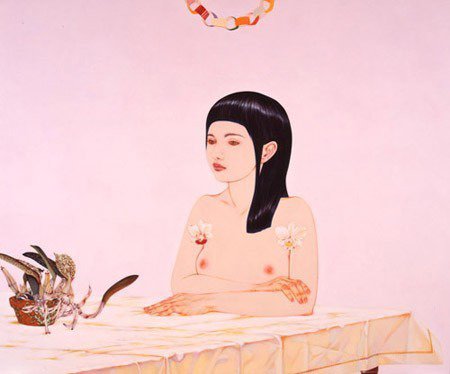Masako Ando
dal 11/7/2012 al 18/8/2012
Segnalato da
Hara Museum Tokyo Press Office
11/7/2012
Masako Ando
Hara Museum, Tokyo
The Garden of Belly Button. Masako Ando paints children, animals and plants on porcelain-smooth canvas surfaces. Her works are characterized by delicate lines, multi-layered colors and a depth that seems to draw the viewer in. Images are set as they flow out from her fingertips.

Masako Ando paints children, animals and plants on porcelain-smooth canvas surfaces. Her works are characterized by delicate lines, multi-layered colors and a depth that seems to draw the viewer in. Hara Documents 9 Masako Ando: The Garden of Belly Button is the first solo exhibition at a museum of this superbly talented young artist who probes the interval between reality and unreality in search of moments that give rise to a picture. Gathered together are 17 works, most of which are appearing in public for the first time. We invite you to experience Masako Ando's rich narrative world of living creatures that breathe and exude a charm that can only be appreciated by the naked eye Like the internationally acclaimed artists Yoshitomo Nara and Hiroshi Sugito, Masako Ando (b. 1976) studied under Nobuya Hitsuda. It was during this time that she began making paintings without regard for the prevailing trends and fast pace of production, with her own sensibilities as her sole guide. As part of her creative process, Ando meticulously collects and combines bits and pieces of memories, words and reality, carefully developing the ideas for her paintings. Because of the long gestation time of her works, Ando has to date shown some 10 works and has participated in three exhibitions, including two group shows and one solo exhibition at a gallery (2004). For the current solo exhibition, her first at a museum, a total of 17 works will be on display, 12 of which were created after 2004.
Ando works in pencil and oil paints. In an age that offers a vast range of materials and methods, she makes do with these two mediums alone. She lavishes equal adoration on her various motifs, all of which are living things like children, animals, insects, plants and flowers. These things, which breathe and live in her paintings, cannot be encompassed in a single glance. Their surprising delicacy and subtle colors become apparent only through close examination of the various nooks and crannies within the picture plane. Each item is painted with equal affection, passion and concentration.
Pencil drawings, the artist says, allow her to ″engage my feelings with ease.″ Images are set as they flow out from her fingertips. For her oil paintings, drawings serve as a base over which she lays down opaque lines and multiple transparent glazes as part of a dialog with the color image. She uses a brush or the palm of her hand to spread the pigment thinly and sandpaper to polish the surface until it is as smooth as porcelain. Ando's superb technical skills allow her to imbue her subjects with a textual quality that gives them a striking realism. And yet the polished surface eliminates all traces of the artist's hand, the pigment's physicality and other signs of tangible rawness, to impart an intangible, imaginary quality to the image, like that of a reflection in a mirror. In her paintings, this is the interval between reality and unreality in which Ando searches for moments that gives rise to pictures.
The name of the exhibition, The Garden of Belly Button, is also the name of an exhibited work. The title, Ando says, expresses a place ″where something on the verge of being born permeates the air.″ At the Hara Museum, originally a private residence, the memories of many people precipitate within its spaces and small creatures and plants breathe within its gardens. Like the paintings of Masako Ando, it is a place filled with things on the verge of being born, a birth to be triggered perhaps by an encounter with the visitor.
The things depicted in Ando's paintings are no mere icons. They have a power to draw the viewer into a world that is meant to be ″experienced.″ We invite you to come feel this power.
Image: © Masako Ando
Sphinx, 2007
oil on canvas mounted on wood panel
99.7 × 120.0 cm
TAKAHASHI COLLECTION
Courtesy of Tomio Koyama Gallery
Hara Museum
4-7-25 Kitashinagawa, Shinagawa-ku - Tokyo



